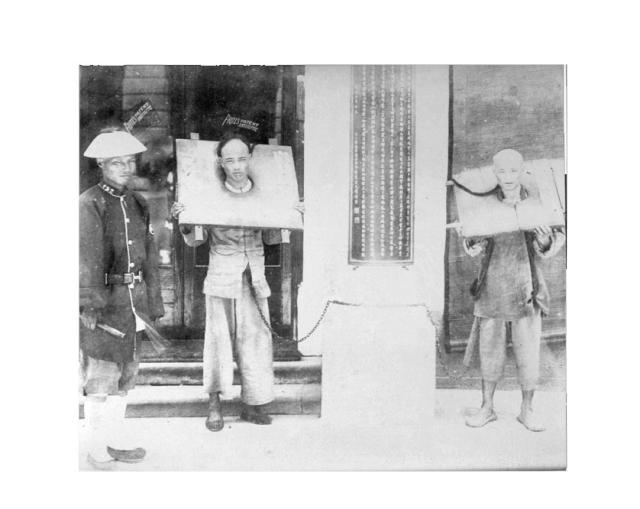Photo supplied from John Breen's private collection.
There is also a copy of the same photo in the Royal Asiatic Society collection in London.
A Bonhams catalogue dates it to the 1880s: http://www.bonhams.com/auctions/11946/lot/28/
The number on the policeman's collar is 132 - can anyone identify the year from that?
I'd also be very interested to know if anyone recognises the location.
Regards, David
Date picture taken
1880s
Gallery

Comments
Inscription & location
Thomas notes that despite the Chinese inscription, we can see a couple of advertisements for "Fritz's patent antiseptic" in the background above the heads of the policeman and the prisoner on the left.
That makes me think we're in Hong Kong or Shanghai. I found a couple of photos showing Chinese poliecemen in Shanghai:
http://www.virtualshanghai.net/Photos/Images?ID=25201
http://www.virtualshanghai.net/Photos/Images?ID=14853
In both cases their uniform has two lines of buttons down the front of the jacket. But in this photo there is just a single line of buttons, and as it matches photos of Chinese police uniforms shown in the Hong Kong Police Museum, I'll say this photo was taken in Hong Kong. Confirmation / correction welcome!
The inscription is not very clear to read, but the RAS copy shows it a bit better. Can anyone recognise what it was talking about? (Click the image for a larger copy you can zoom in on)
Regards, David
Re: Location
Just an observation. I think at the time the Victoria Dispensary was opposite the Court House on Queen's Road Central
Prisoners in cangue
The scribe is pretty illegible. If you could blow it up some more, I might be able to make something out.
regards,
S.W.
The best resolution I have is
The best resolution I have is if you zoom in to https://gwulo.com/atom/16204/zoom - but that's still not very clear, I'm sorry to say.
The cangue in Hong Kong?
This is a puzzle:
1. Under the Magistrates Ordinance in force in the 1880s (No. 16 of 1875), magistrates were empowered to sentence people to the stocks - i.e. the leg stocks: these appear in several other photos on gwulo. An earlier ordinance, No. 10 of 1844 s. 25, had allowed magistrates to sentence Chinese offenders to 'such punishment, in conformity with the usages of China, as has hitherto been usually inflicted on natives of China, committing offences in this Colony.' But this provision was repealed by the 1875 ordinance.
2. The Supreme Court, sitting in the courthouse on Queen's Road, had no powers to impose the stocks or 'Chinese punishments' (attempts to allow this in 1844 had been rejected by the Colonial Office in London - some months after the court had imposed the sentence on a woman). Only magistrates had the power to impose the stocks in the 1880s. In any case, the portable leg stocks were used in various parts of the city, usually near the scene of the offence. So the possible location opposite the courthouse on Queen's Road is a red herring.
3. It is unlikely that such scenes would have gone unnoticed by the newspapers in Hong Kong (and therefore picked up by Norton-Kyshe in his voluminous work), or by other commentaries. Perhaps they were, but I have not come across any references.
4. Even so, the policemen and the architecture do make this look like Hong Kong. It could be staged (as the Shanghai photos seem to be). Or it could be genuine, despite all of the above. Or is in or near the foreign concession of some other city, such as Canton?
David: Is there any chance of using your special technology to refine the inscription even further? That might have an answer.
Further Information
The University of Bristol - Historical Photographs of China provides this reference: https://hpcbristol.net/visual/ld-m09
A higher resolution : https://www.alamy.com/prisoners-wearing-the-cangue-china-image66166409.html?imageid=DE3E2E32-C34D-4A09-BA30-987EB0409170&p=181734&pn=1&searchId=d55025e137b7c3ccdb5feff116f511a4&searchtype=0 (Click on the image)
So far, I have not seen photographs of the cangue used on prisoners in Hong Kong.